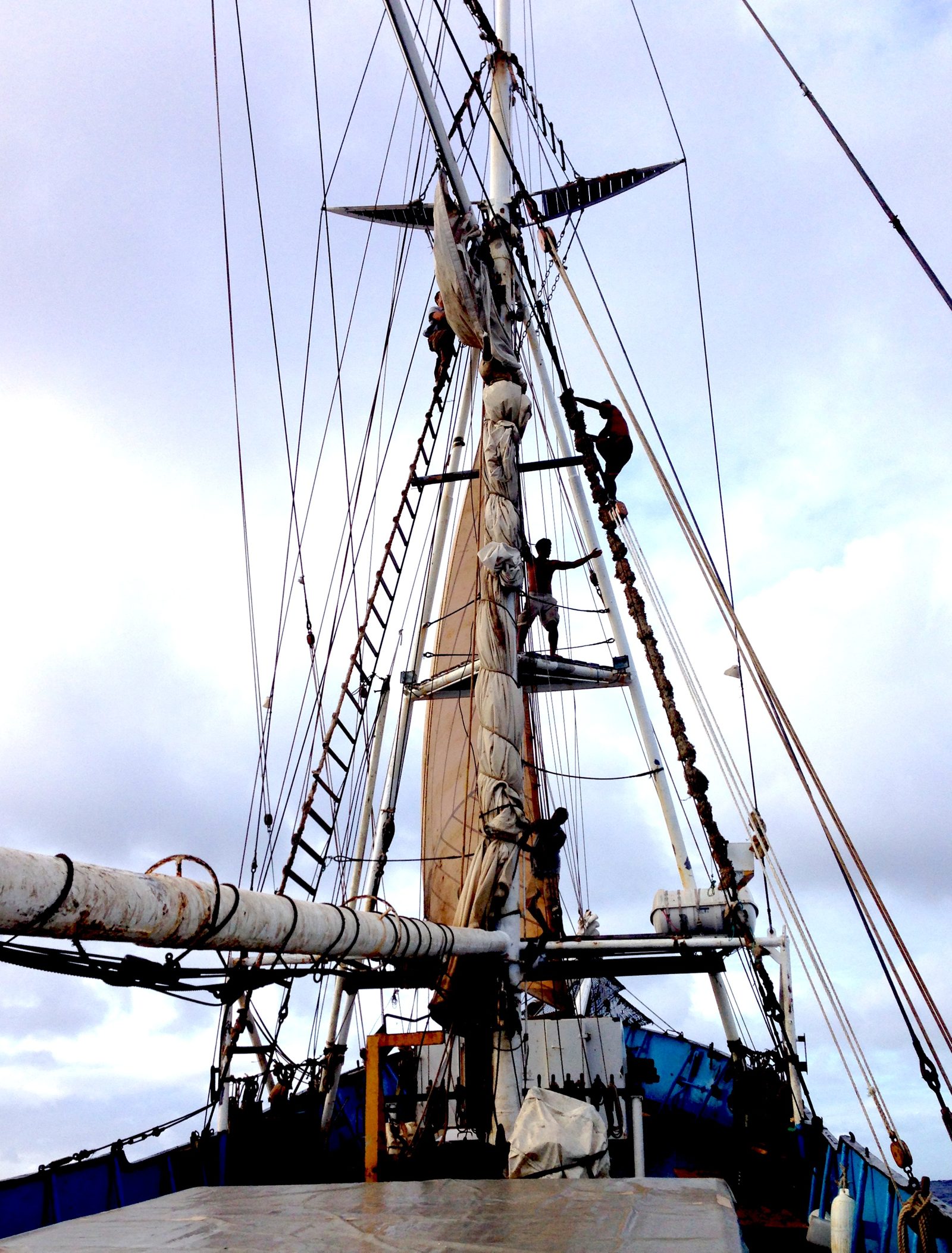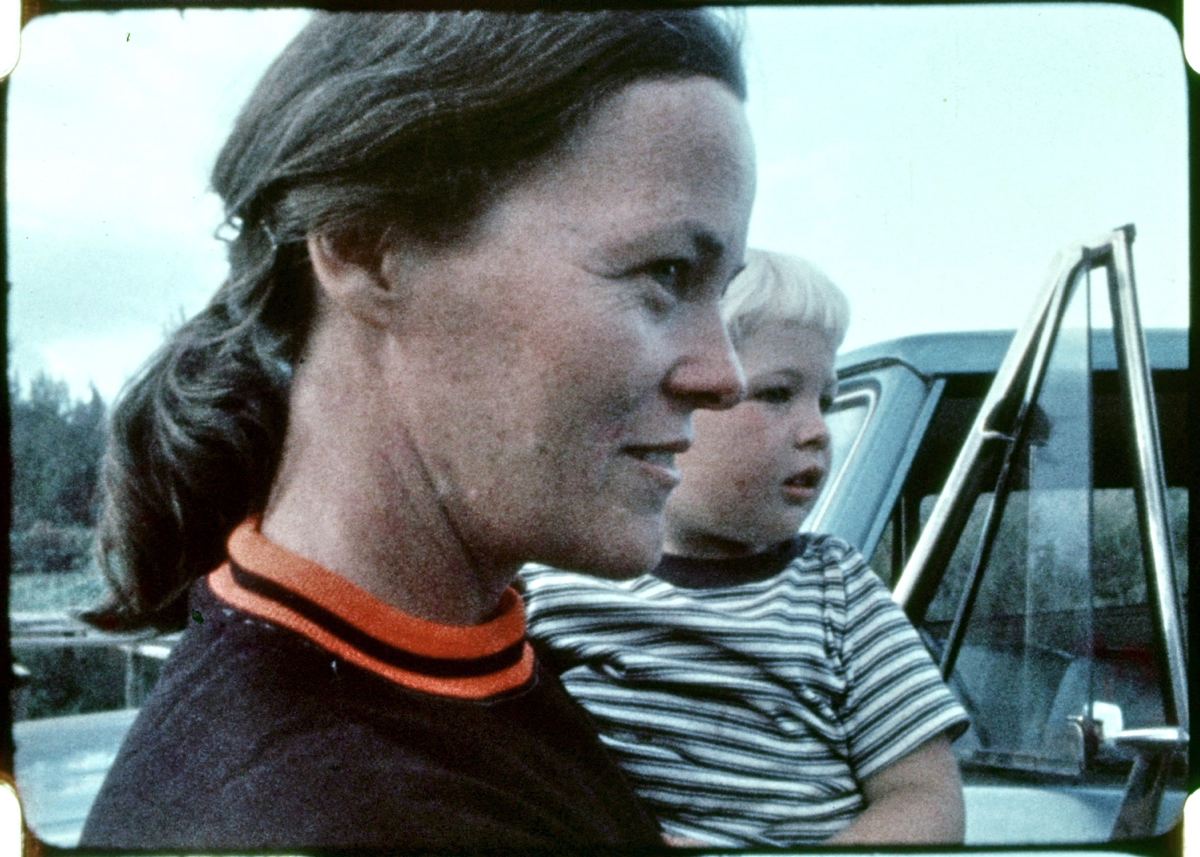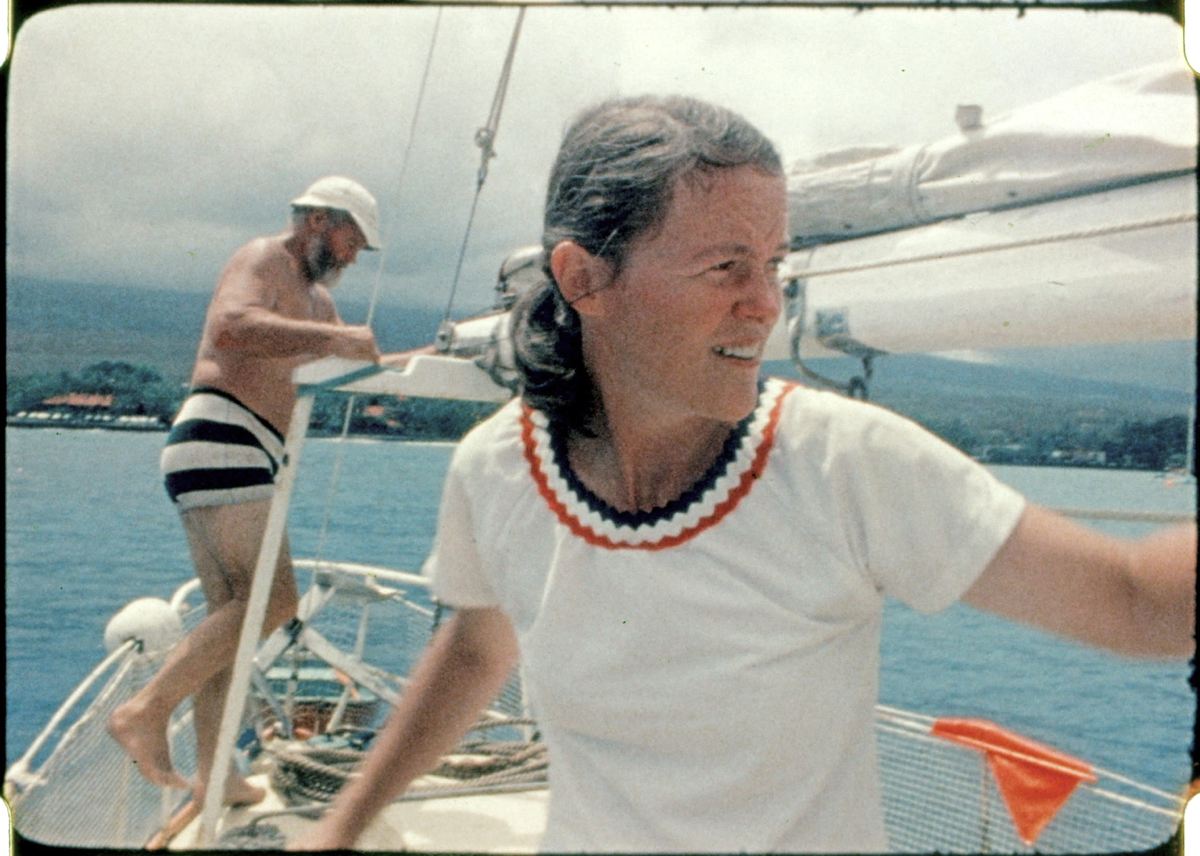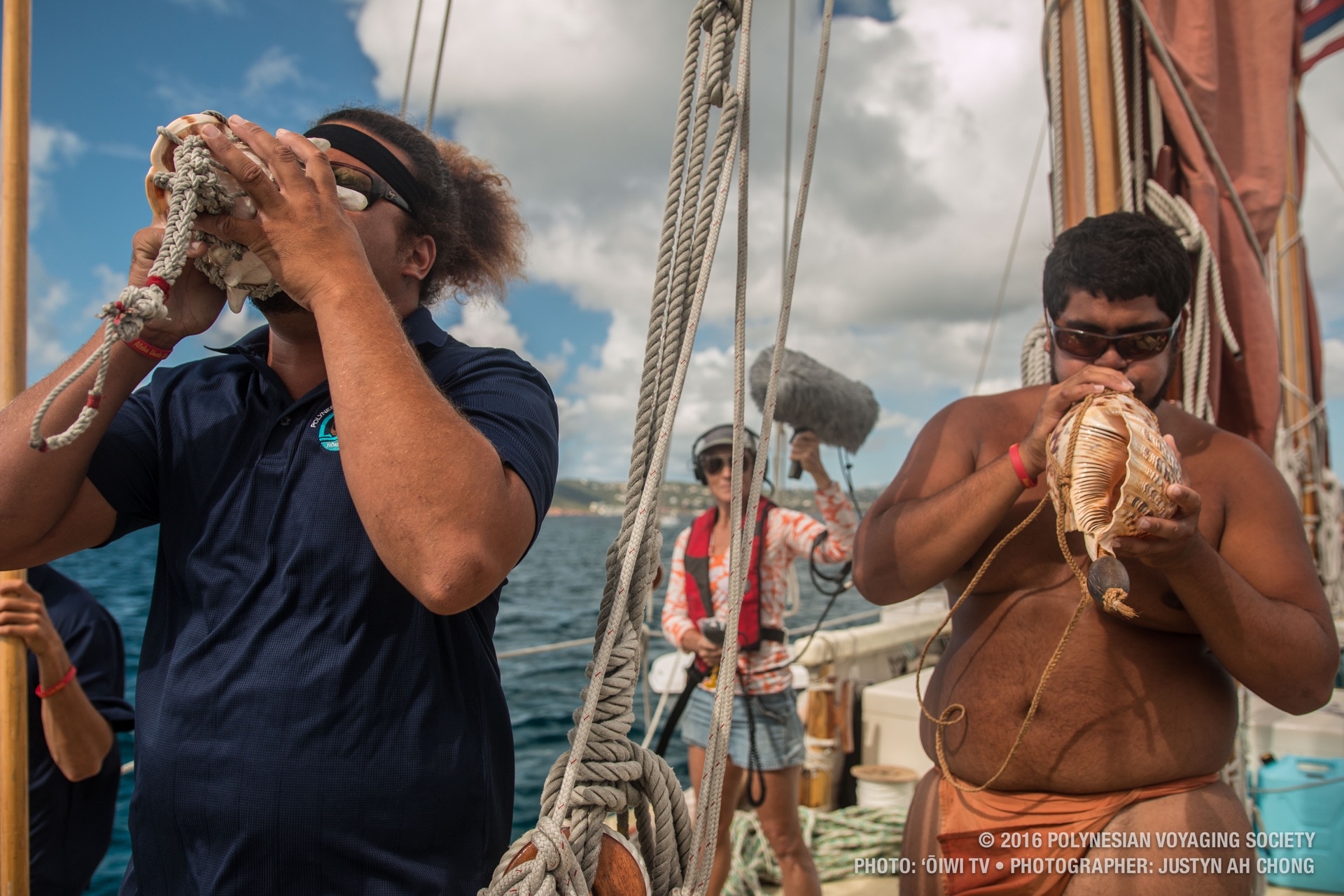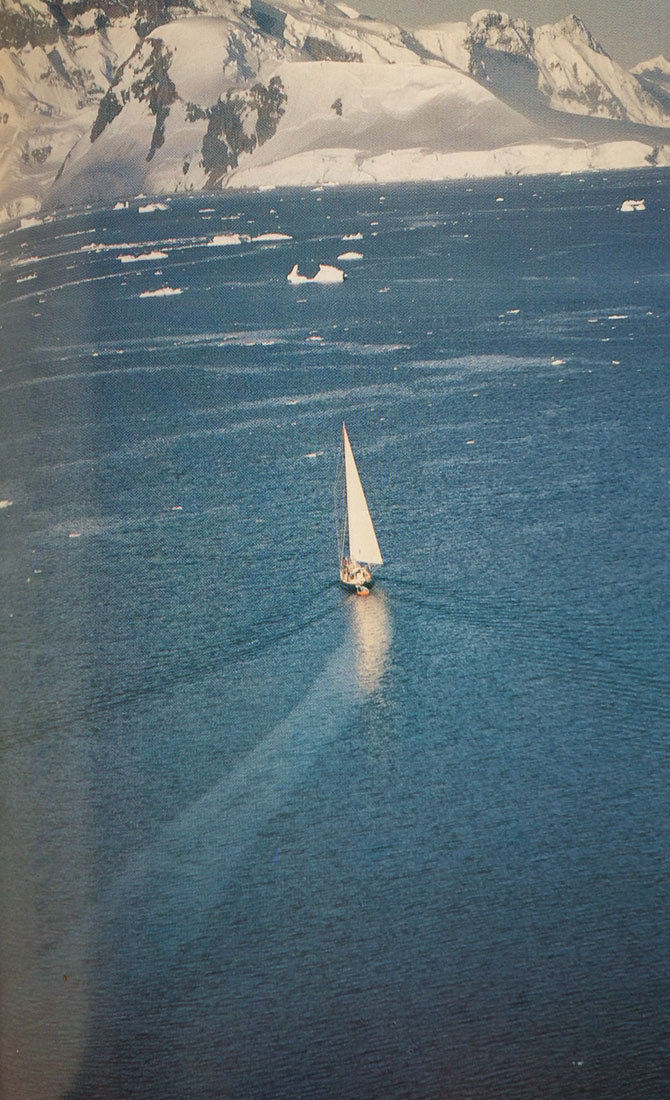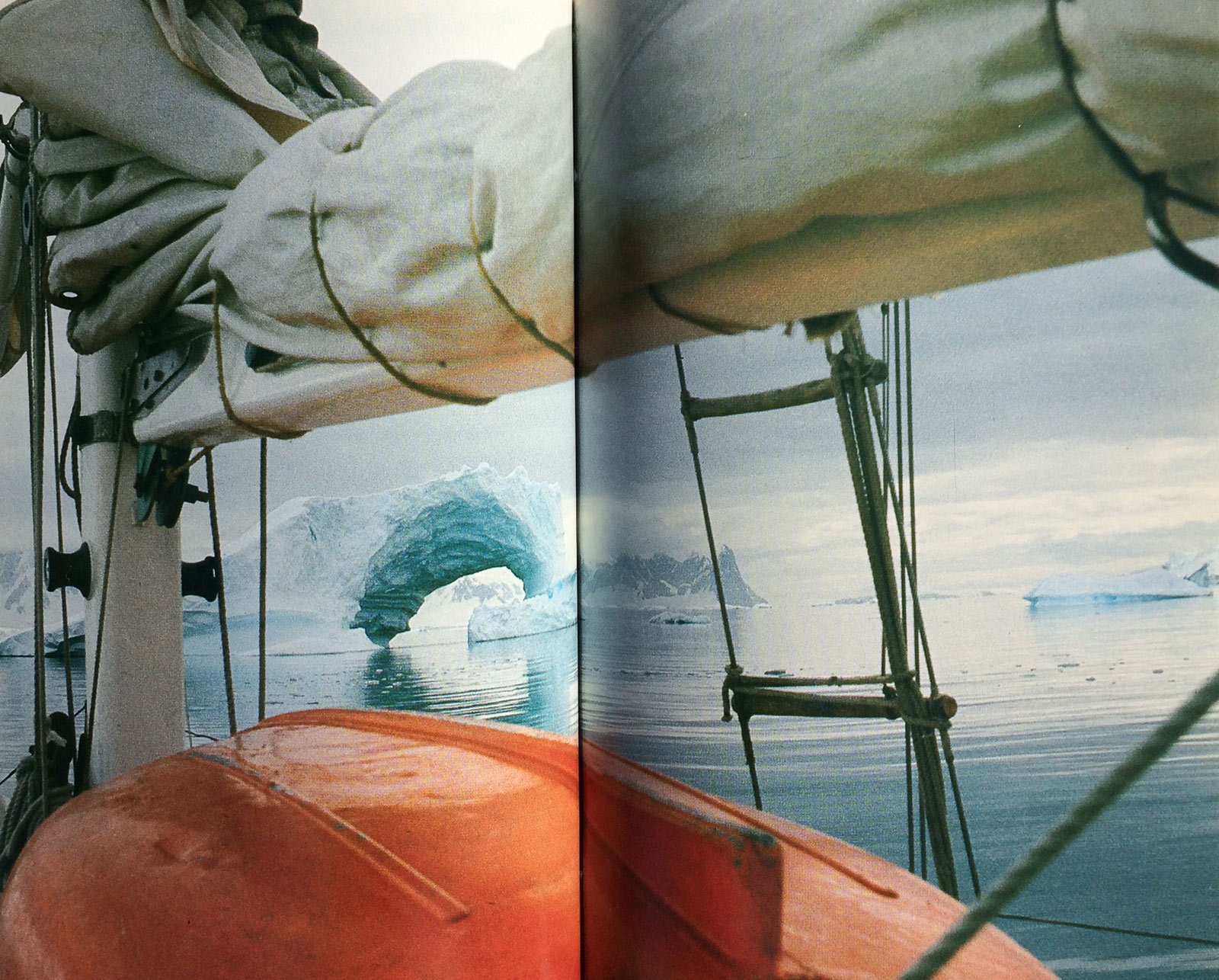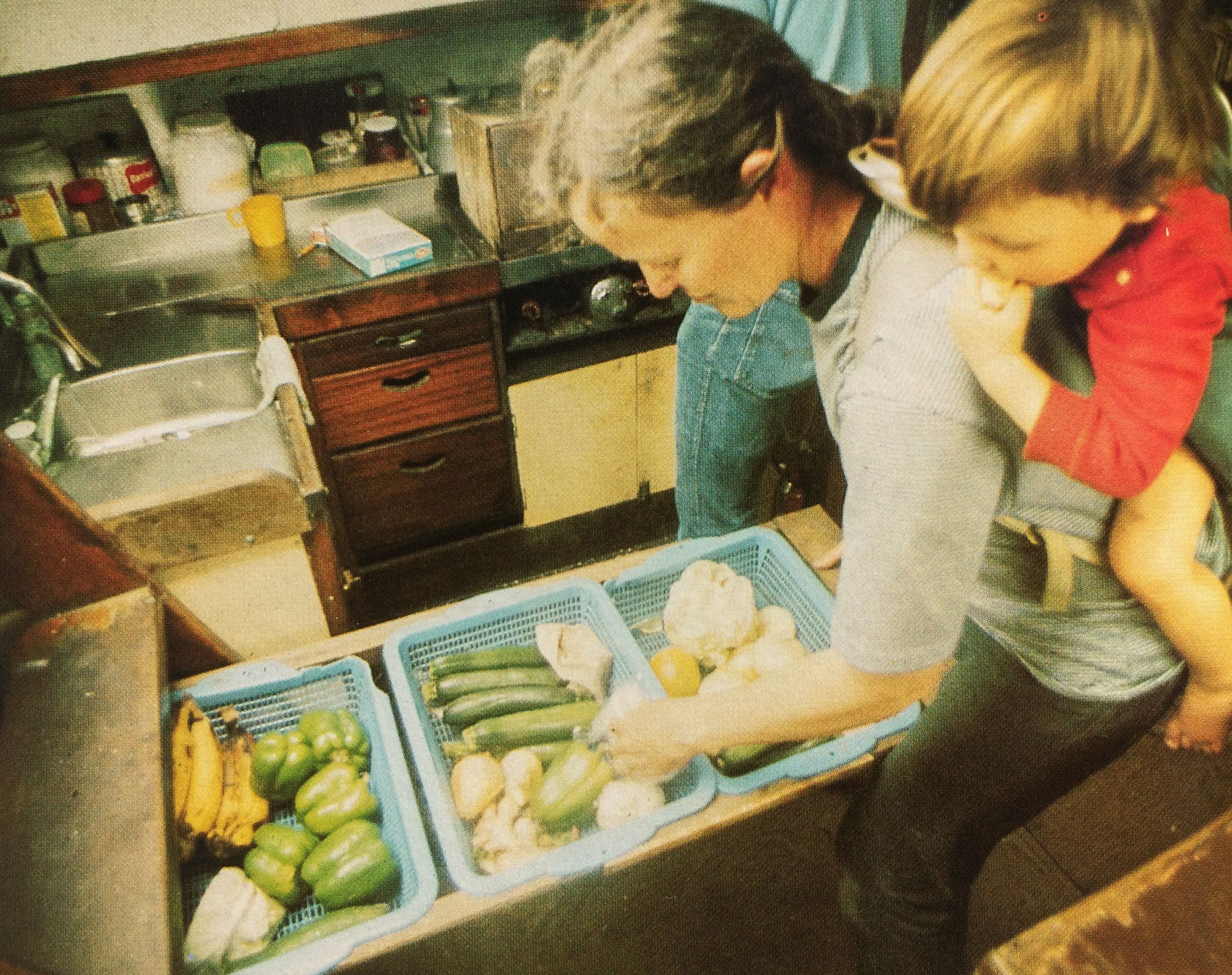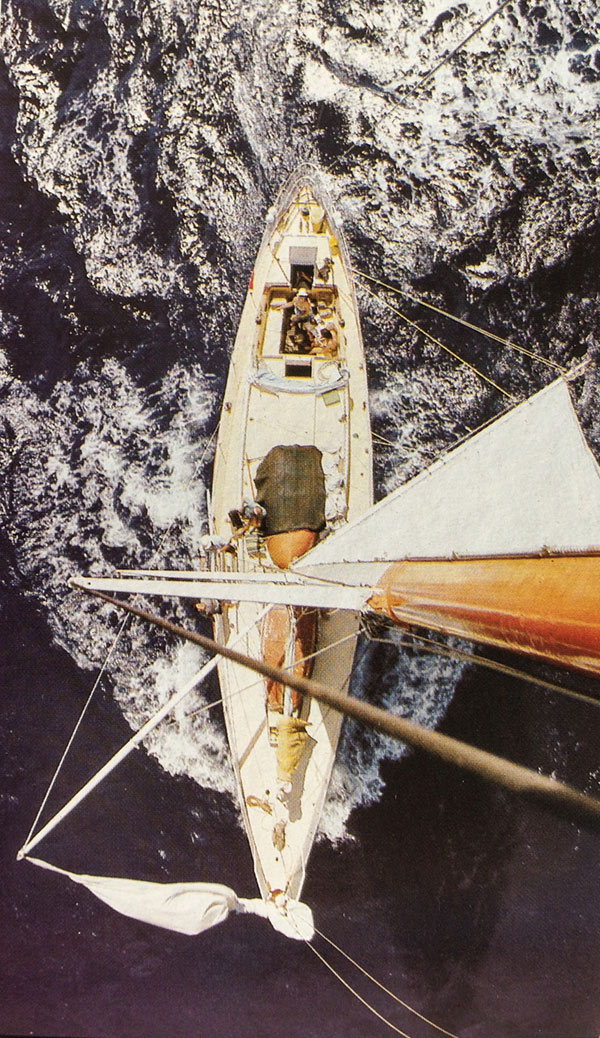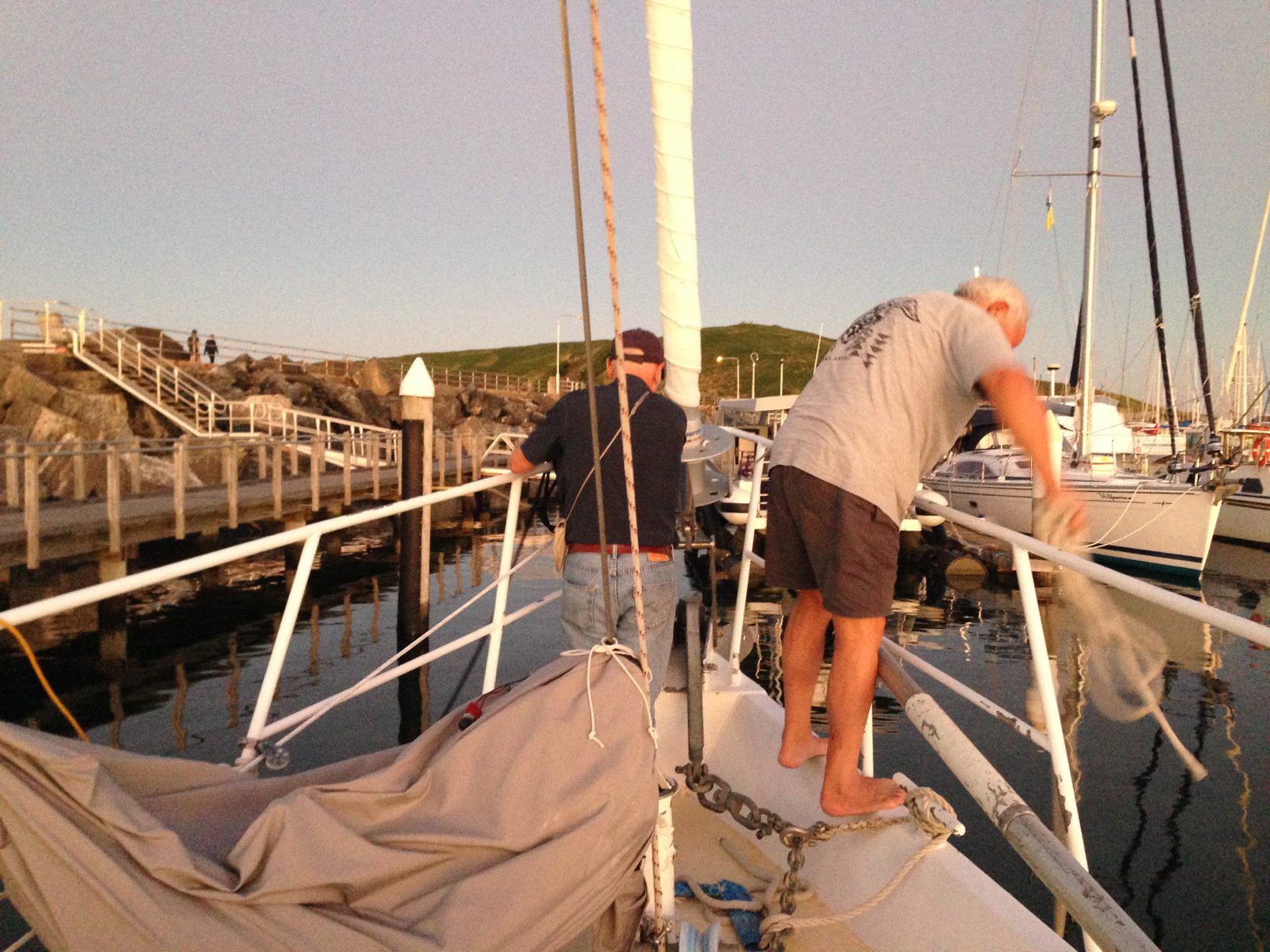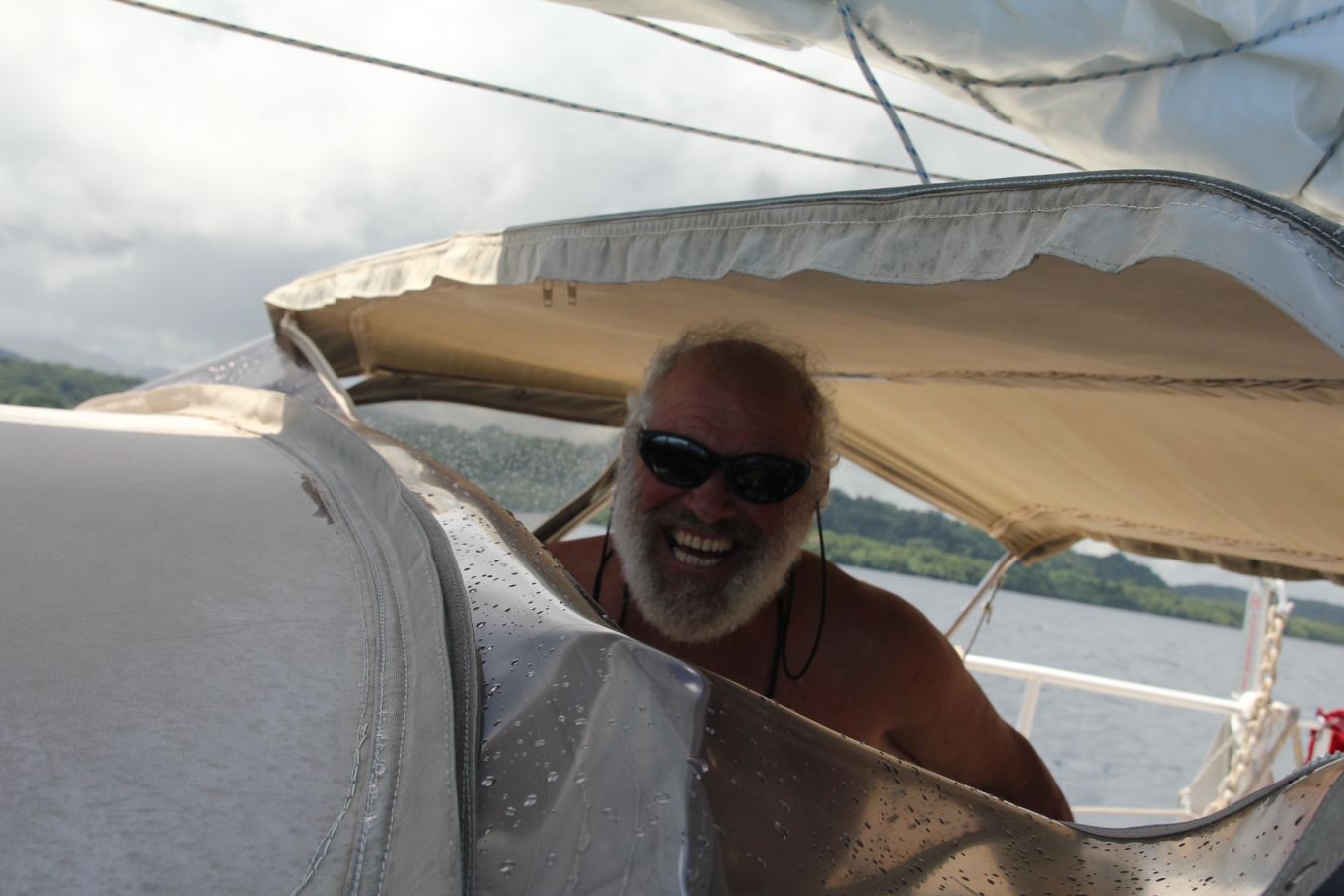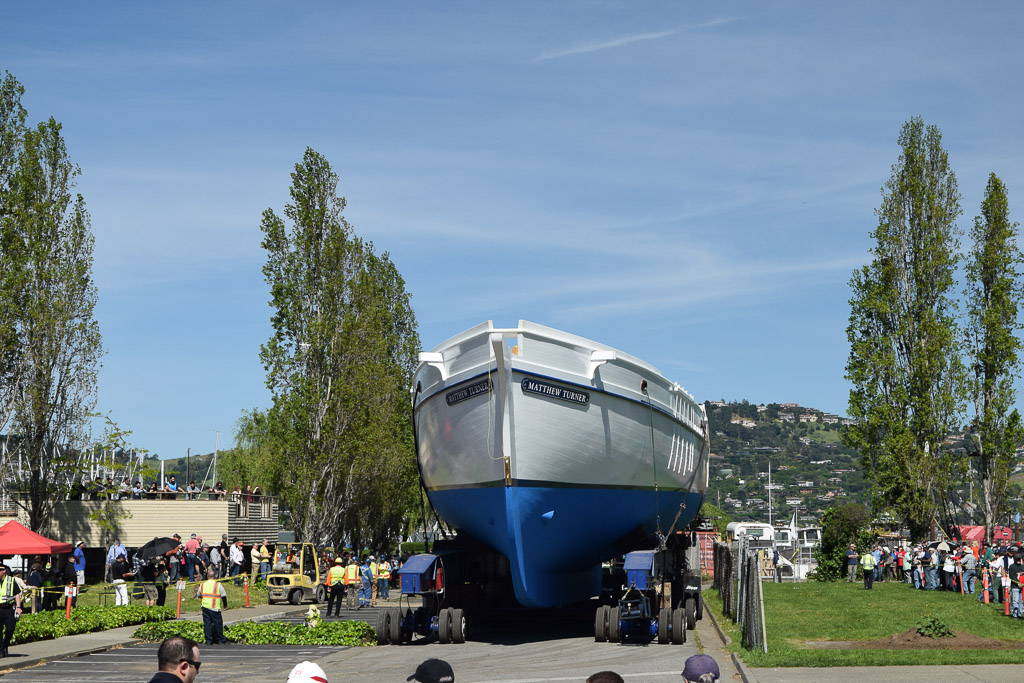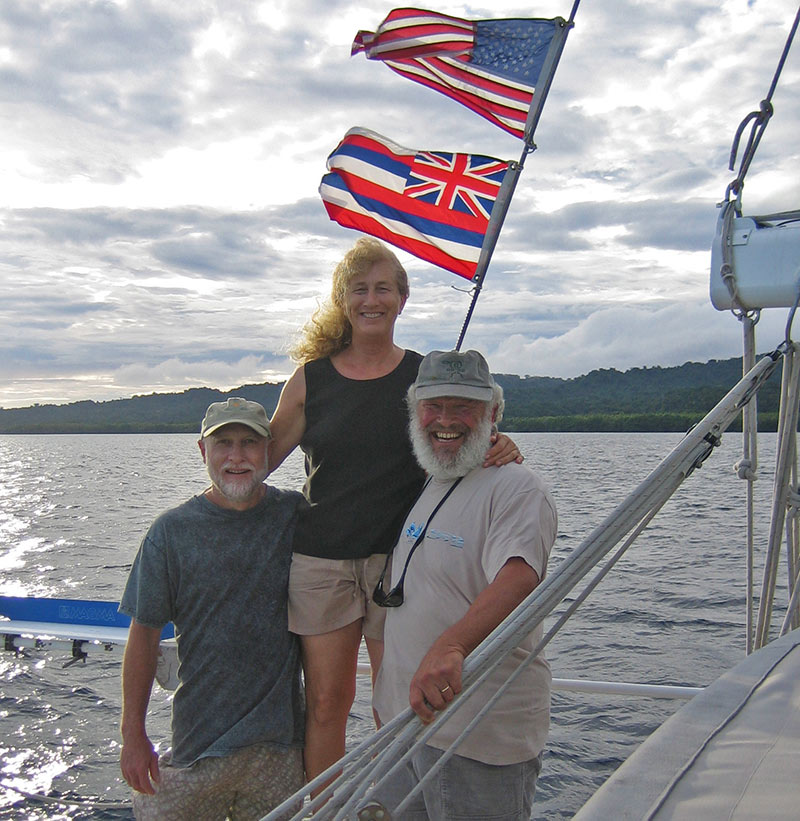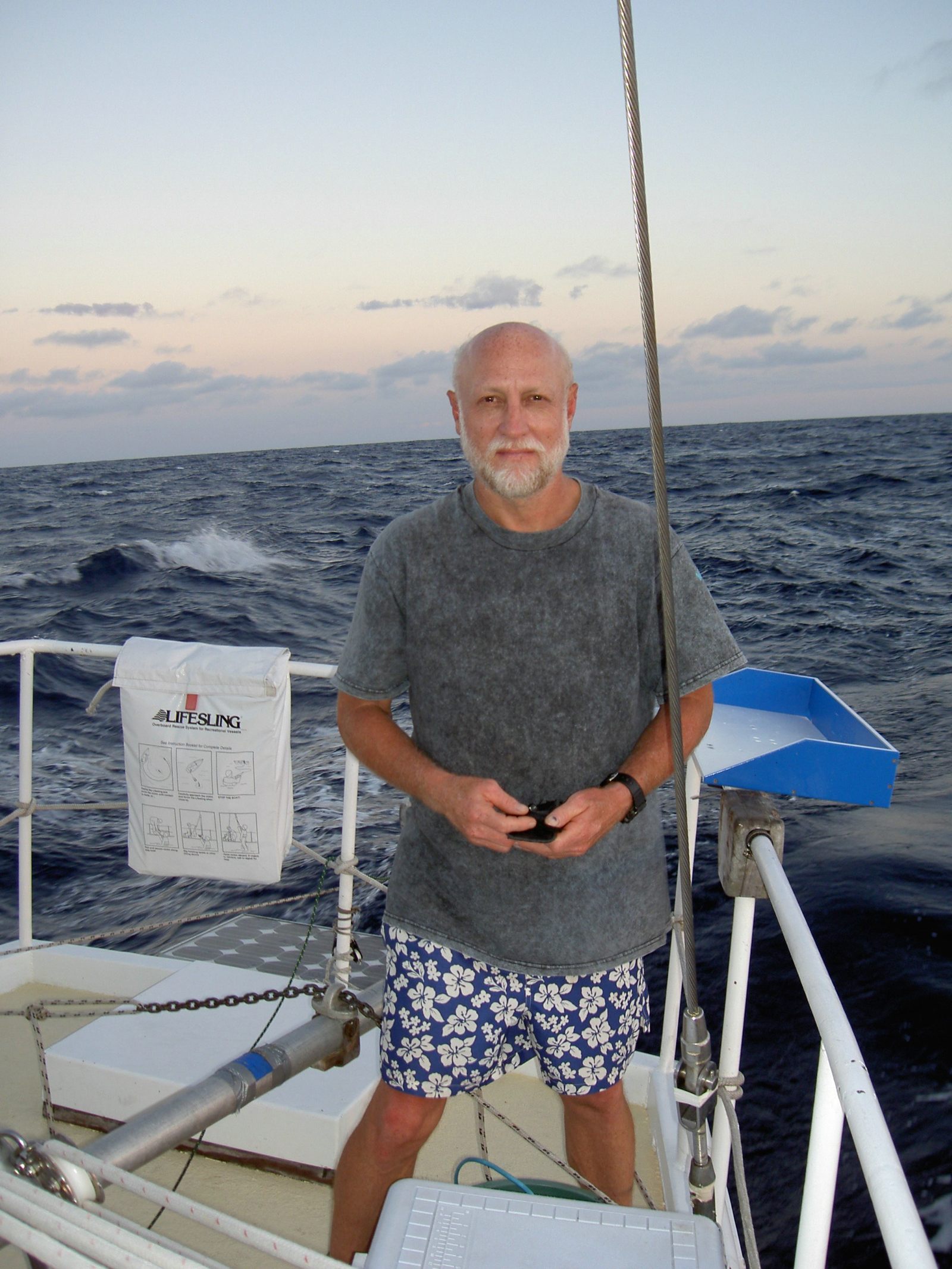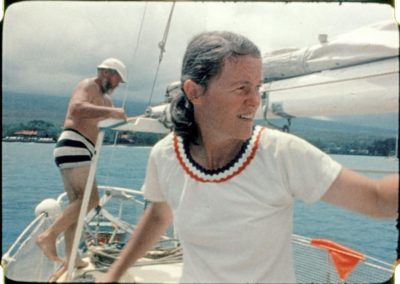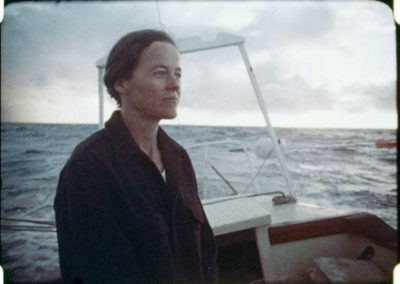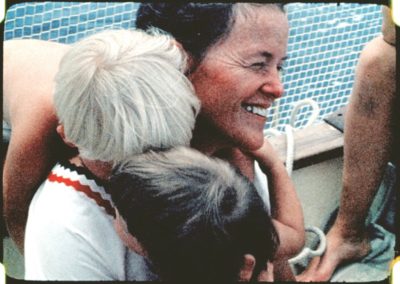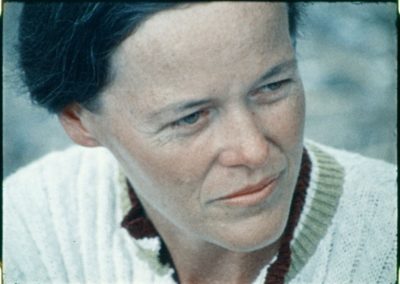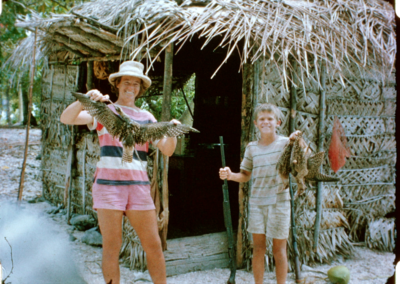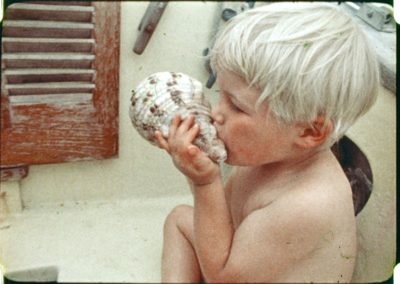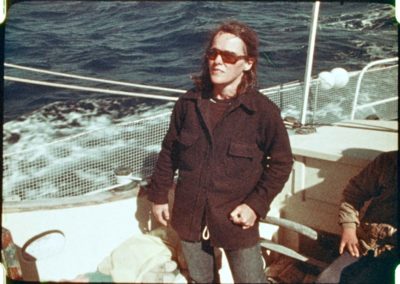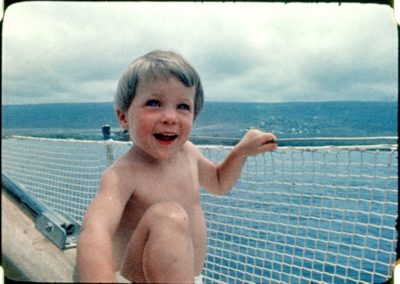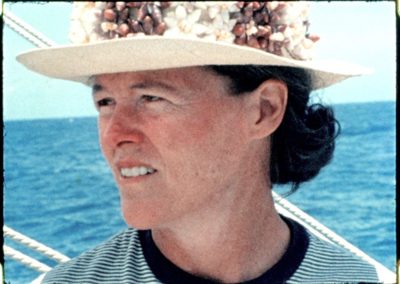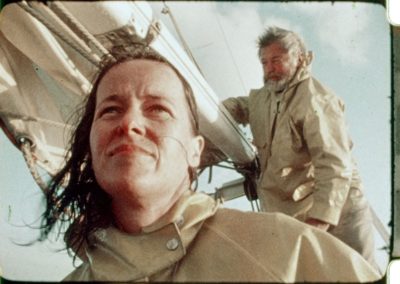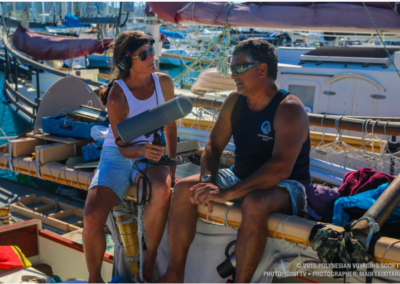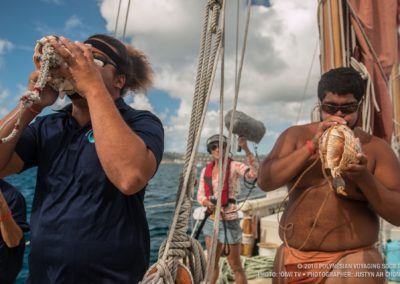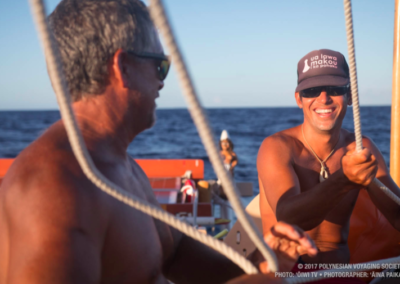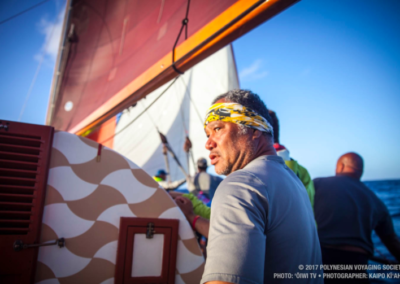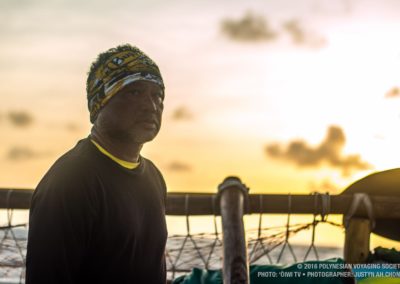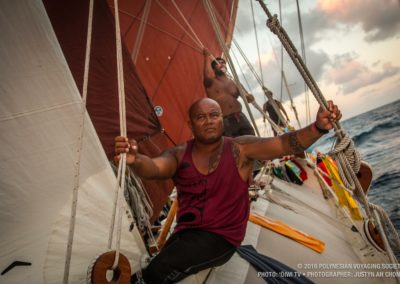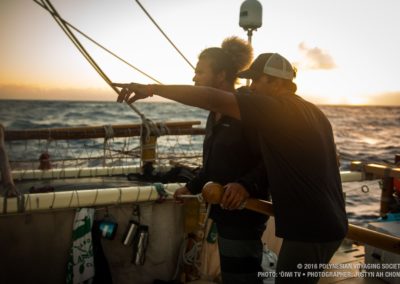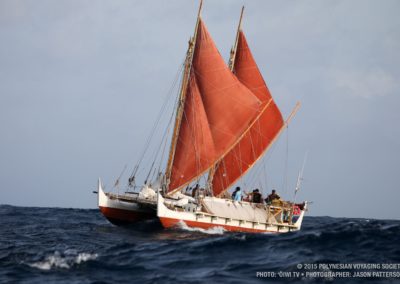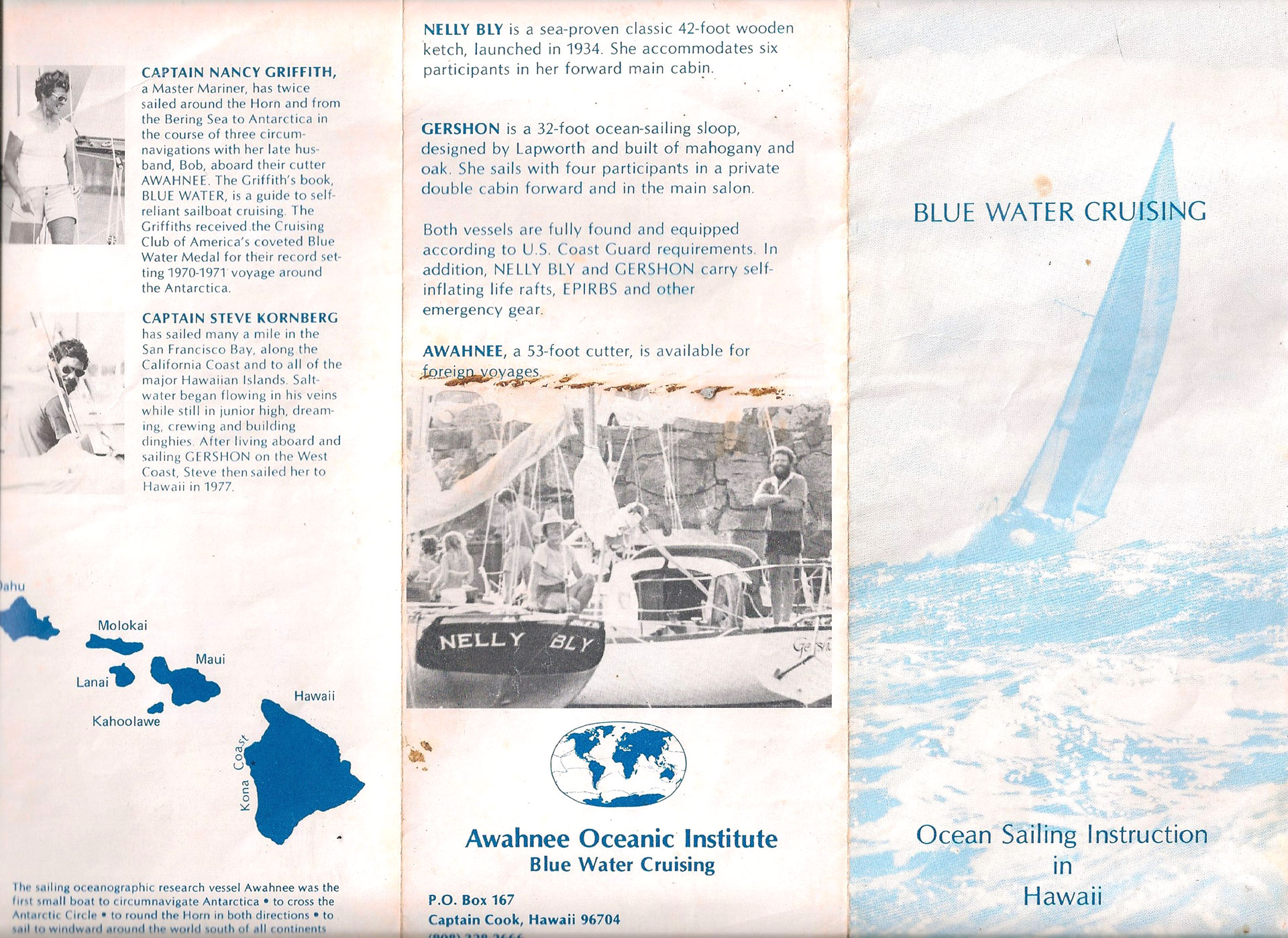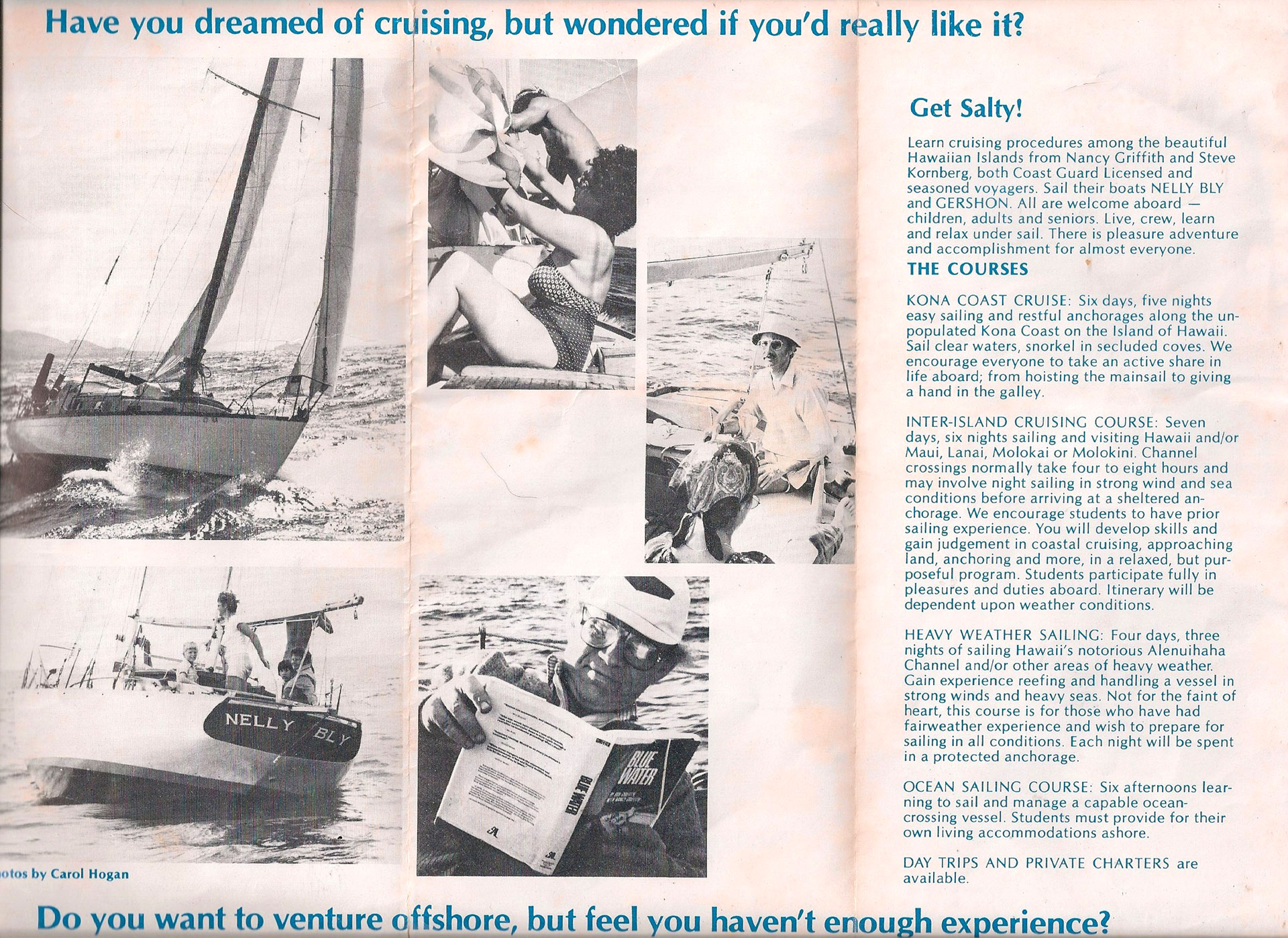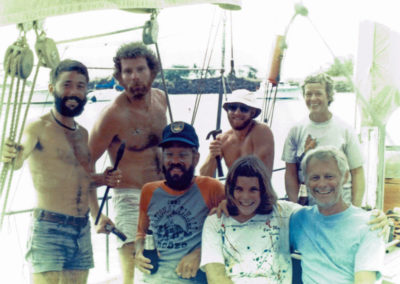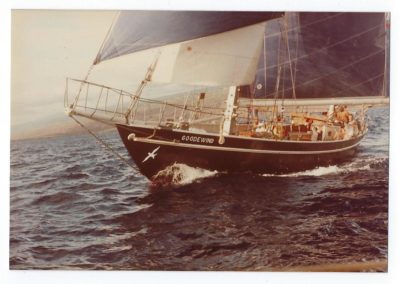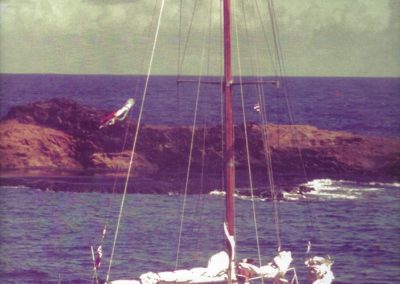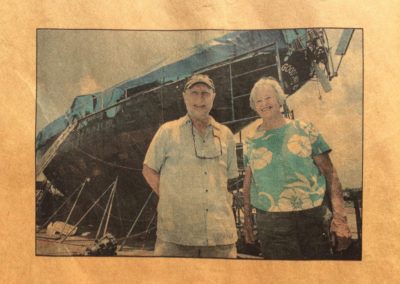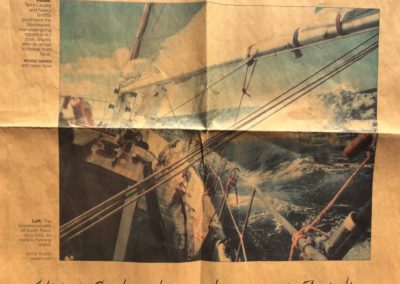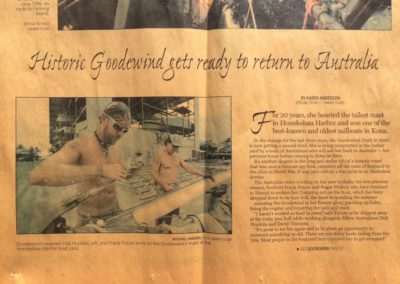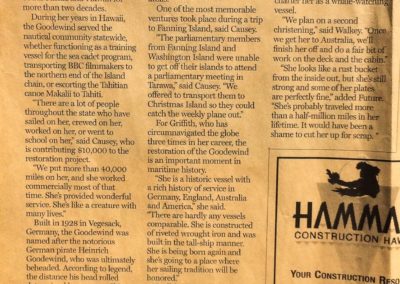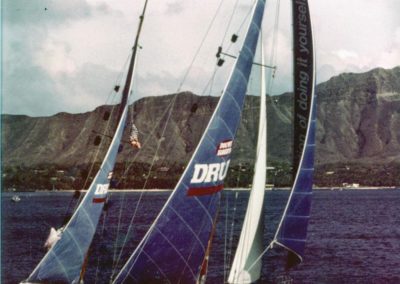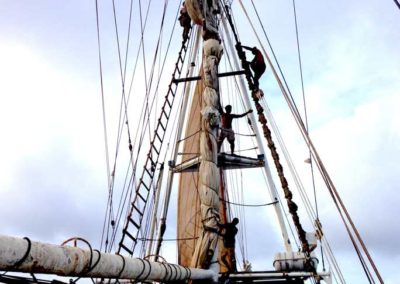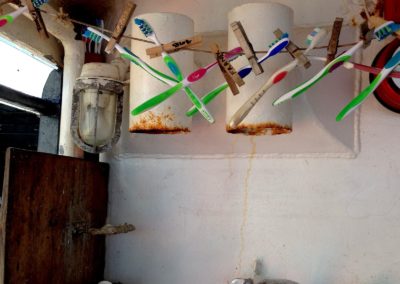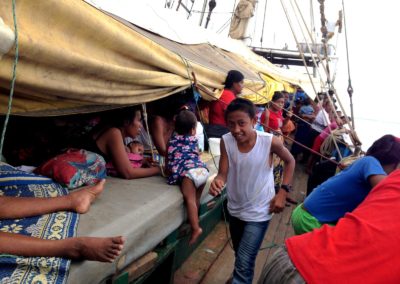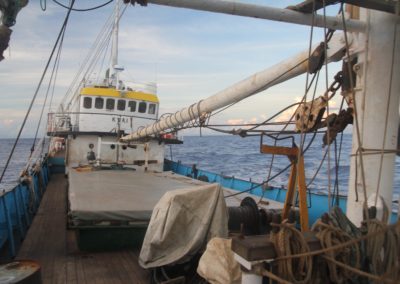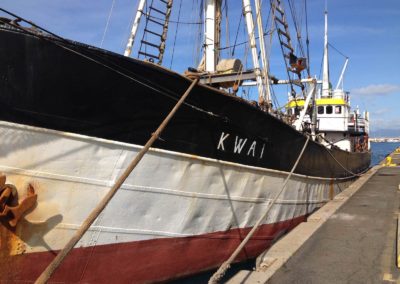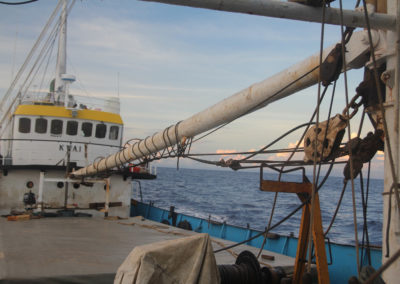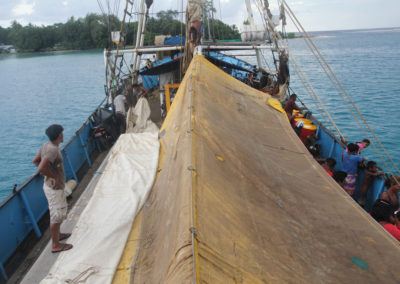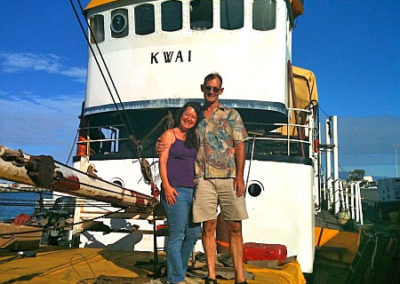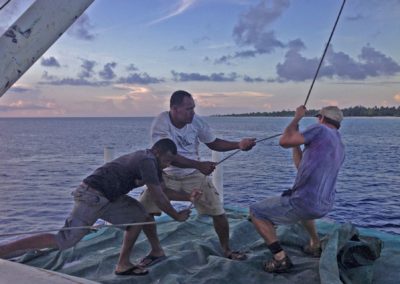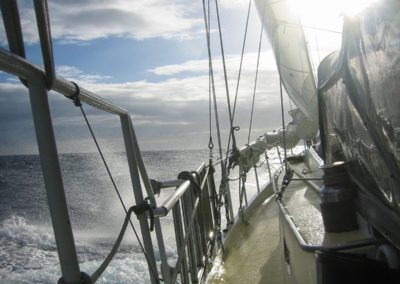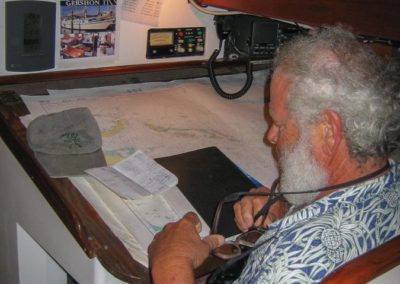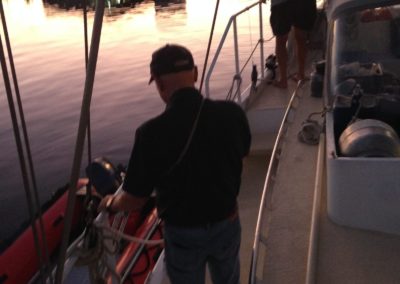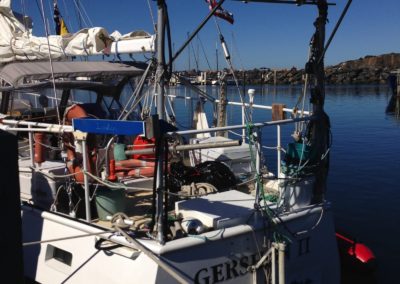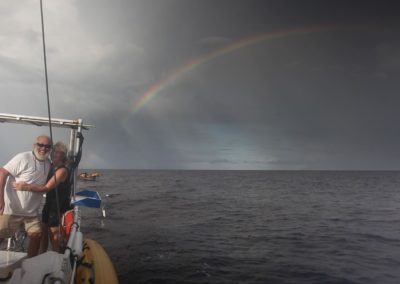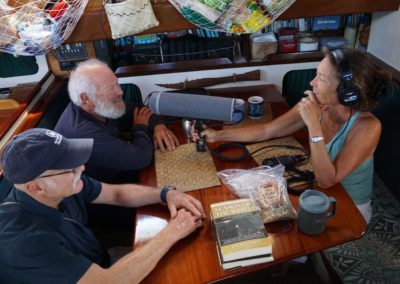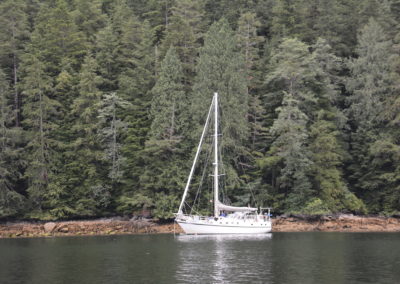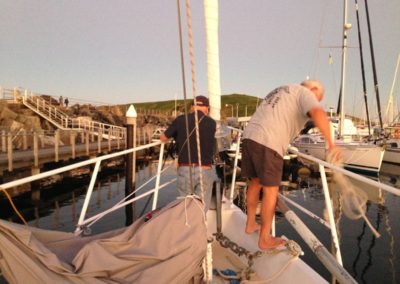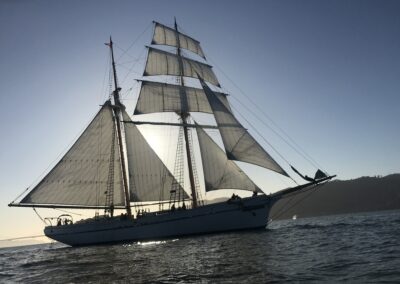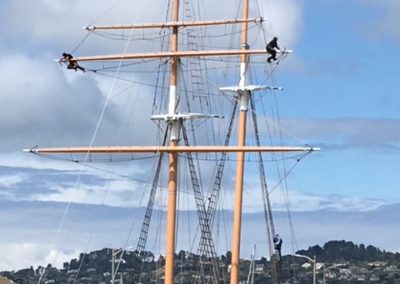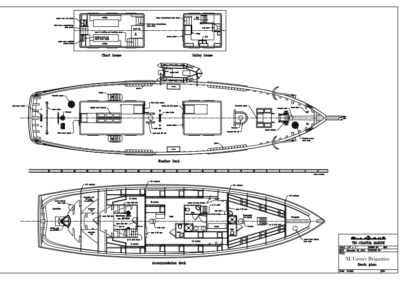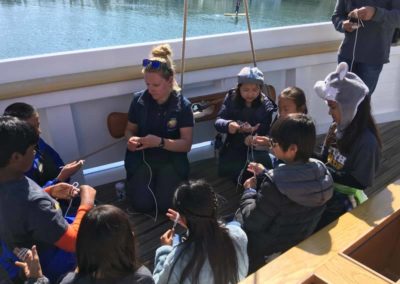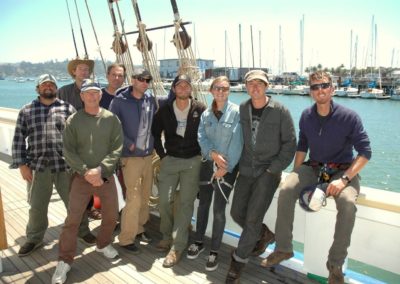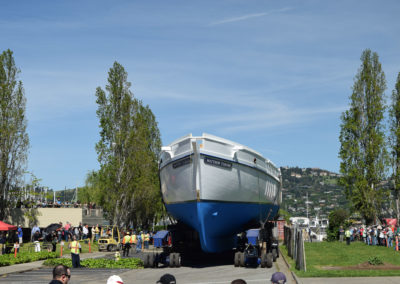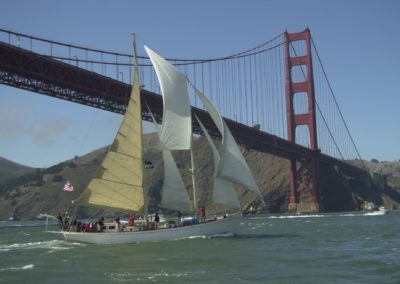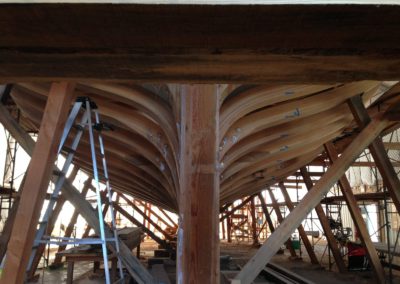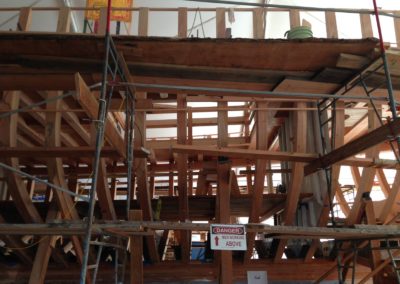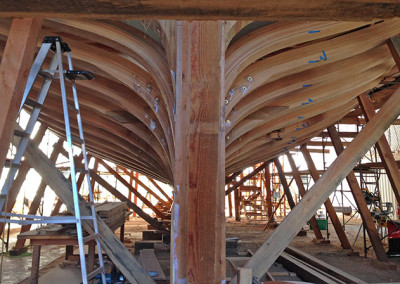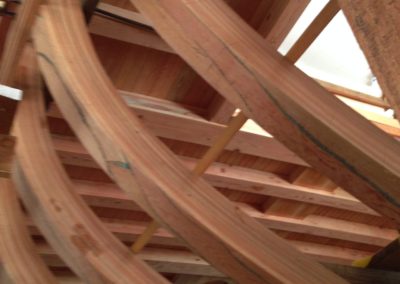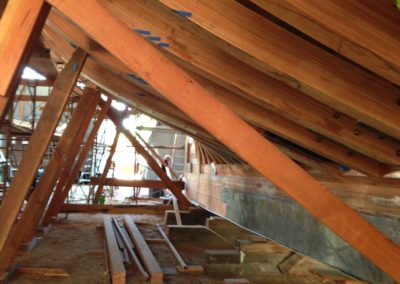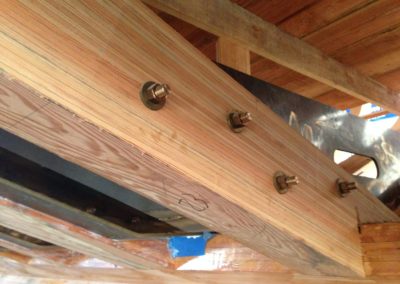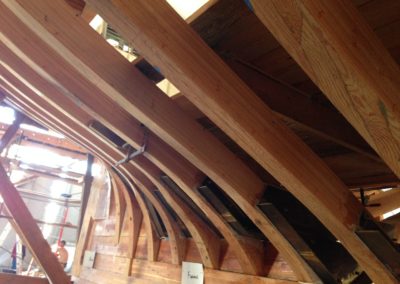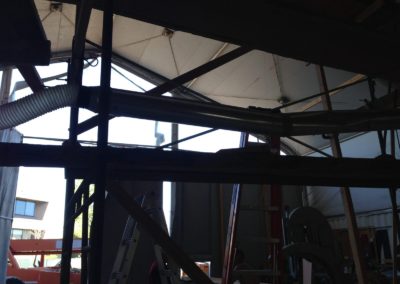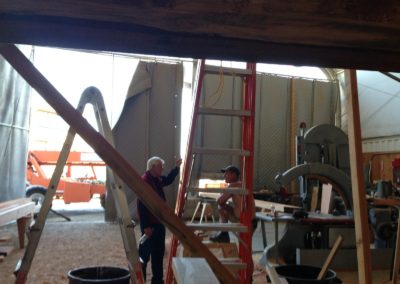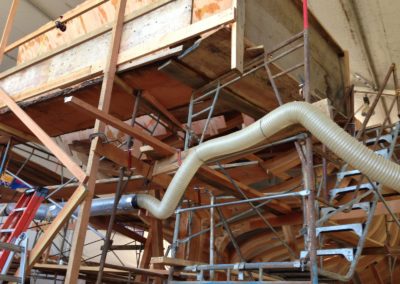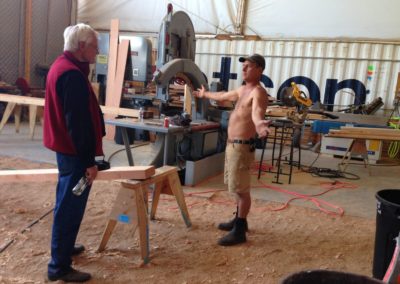Back in 2005, Outer Voices first laid plans to travel to the Polynesian outliers of Temotu Province in the Solomon Islands. We had been invited there by anthropologist Mimi George to document a group from that island , called Vaka Taumako., who were working to reclaim their traditional navigation and boat building knowledge.
The problem? There was honestly no way to get there.
Well, almost no way.
Enter Steve and Cheryl Kornberg, and their boat, the Gershon II, along with Terry Causey, their time and their skills to sail us there, by way of the neighboring island nation of Vanuatu, and eventually they’d sail us a thousand miles up the Solomon Islands chain to get us to the airport in Honiara, the capital, where we’d fly home. We drew the lucky straw when we found them.
In 2006 I found myself on the Gershon II, a fifty two foot steel hulled ketch, equipped with modern navigation, radio, weather fax, safely in our bunks, with our reading lights overhead, a warm galley with a refrigerator stocked with supplies. That was the boat carrying us, sailing across the Coral Sea, the sky a bucket full of stars overhead, with no sound except the hull making a wake at seven knots through the smooth water.
Once we were finally on the boat and underway, we’d talk with our crew at night, listening to stories of their own amazing adventures of shipwrecks, escapes from the law, boats bought and sold, and islands rising up from the sea.
It was hard to ignore the obvious truth: their stories also had to be told some day.
In the process we learned another larger truth: that all relationships do indeed exist in a circle, or maybe a spiral. On our first trip with the Gershon II, she was just our means to getting to where we wanted to go: to meet the Polynesian navigators and boat builders of the Solomon Islands.
After that, the tables turned. We followed the Gershon II as it sailed with the Hokule’a as an escort boat. First built in 1974, with a design based on historical drawings of the original Hawaii’an sailing canoes, the Hokule’a was the dream of Hawaiian islanders who were taking the radical step of reclaiming their heritage. By following the Gershon II we were now getting to know the Hawaiian navigators and sailors on the Hokule’a.
Both Vaka Taumako, the group we hoped to document in the Solomon Islands, and Hokule’a, the Hawaiian group, wanted to reclaim legitimacy. They wanted to disprove the common theories that Pacific Islanders didn’t have the knowledge or sophistication to be able to build boats that could sustain long ocean passages, and they wanted to prove beyond a shadow of a doubt that Pacific Islanders’ navigational knowledge was sophisticated enough to get them between islands – that their migration from atoll to atoll was intentional, not an accident. It might sound obvious now, but if it does, it’s because of the work of groups like Hokule’a and Vaka Taumako that have spent decades trying to set the record straight.
Outer Voices’ documenting work in the Solomon Islands turned into assembling an extraordinary jigsaw puzzle of boats and people whose lives crossed. Even the Pacific isn’t big enough to keep them from finding each other there, sometimes truly mid-ocean, or colliding on a tiny coral atoll. It hasn’t kept them from partnering on voyages and on finding a way to make their voyages turn a profit. In all kinds of ways they have been striving, in parallel lives, to find ways to make their sailing useful for the islands that they sail among. In the case of Vaka Taumako, in the Solomon Islands, and Hokule’a in Hawai’i, the western yachts and sailing ships have played the part of a supporting cast in the efforts by these astonishing indigenous sailors and navigators to prove their primacy in the ocean.
The people in our story come from different backgrounds and from different times but they’ve all found themselves intertwined in an extended community of sailors in the Pacific. Why do they sail? And why do they continue to sail on the wild and rugged Pacific? It’s a complex equation in different proportions of the same ingredients: a love of the wildness of the open ocean; a deep commitment to discovery – of a place, a culture, of one’s own soul; a revival of cultural and tradition; and stark recognition of what a difference a single boat can make in sustaining the inhabitants of far flung islands.
This hardy group of sailors is a small representation of the many extraordinary blue water sailors in the world, but they are the ones who it’s been our privilege to get to know. Their lives and their boats have become inextricably intertwined over the years that they’ve known each other and sailed together. Connecting the dots – the boats, the sailors, the people that call the Pacific islands home.
Here is the story of these Blue Water Cowboys: sailors we’ve had the honor of meeting on land, or sailing with, and the lives they’ve spent on the Pacific Ocean connecting people, islands, and stories. But don’t take my word for it. Let them tell the stories themselves. They’re more than worth listening to. Follow the links embedded in the text to hear their stories in their own words.
For the crew we first met on Gershon II, their story starts with a woman named Nancy Griffith. In the 1950s, Nancy Griffith was learning to sail and loving everything about it. She was enrolled at the University of Hawaii at Manoa, in Honolulu, Hawaii, and going out on a few sailing trips with peers.
Meanwhile, in California, Steve Kornberg and Terry Causey were born, in 1946 and 1950 respectively, and soon thereafter were experiencing the ocean for the first time as young children, discovering their love for sailing.
At the same time, in California, in the late 1950’s, Bob Griffith had retired from his job as a veterinarian and set out to sail full time. He found his way to Hawaii by 1960, and Nancy watched as he and his fifty- three foot cutter Ahwahnee sailed into the harbor, as if it was a simple thing. But in fact, few to none manage to enter the harbor in Honolulu under sail, and Nancy was instantly in love, first with the boat and then the man. Just a year later they married and began sailing all around the world with their young son, Reid, in tow.
Over the next 15 years they would keep sailing, completing three circumnavigations of the world, including a record-breaking trip around Antarctica. Bob and Nancy were known as some of the best sailors at the time, relying exclusively on simple navigational tools – as a sextant, a chronometer and celestial navigation.
STEVE AND TERRY ON NANCY
“‘Can’t do’ was not in her vocabulary. Even in her 50’s — when I first met her — she could climb the rigs… just could do anything, and had this love of live, this love of sailing, and kept up with creative ideas. And then there were her sailing adventures: three circumnavigations in the 60s and 70s… just really inspiring.” – Steve Kornberg
Meanwhile, just north of the equator in Hawaii another historic sail was being conceived. Hawaiian artist Herb Kawainui Kane, anthropologist Ben Finney, and sailor Charles Tommy Holmes, were collaborating on a project, piecing together bits of knowledge to divine what the original Hawaiian sailing canoes would have looked like, and eventually, how to build one. The original sailing canoes were the vessels that brought the original Hawaiians to their islands. In 1973 they founded the organization the Polynesian Voyaging Society (PVS), which they used to raise funds to build this historic canoe, Hokule’a.
Meanwhile, Bob and Nancy had grown to love and admire the islanders they met throughout the Pacific. Bob became a member of PVS, and in 1974 he went to them to ask for help funding the building of a canoe – one that he had designed based on descriptions and illustrations in Captain James Cook’s journals. Bob called his boat The Spirit of Nuku Hiva. He was ultimately rebuffed – his design was not considered historically accurate for the journey he hoped to make from the Marquesas Islands to Hawaii. He built her anyway, but the Spirit met her demise in 1975, 900 nautical miles south of Hilo.
For the team building the Hokule’a, historical accuracy was everything – not only to prove the full extent of ancient Polynesian voyaging skills, but because they intended to sail this canoe all the way from Hawaii to Tahiti using only traditional navigational skills, and it had to be up for the trip.
In 1975, she set sail. Over the years dozens of earnest young Hawaiian sailors would join Hokule’a from across the Pacific islands, developing their seafaring skills, and learning the history and skills of traditional navigation.
When Hokule’a made her maiden voyage to Maui, a young Chad Kālepa Baybayan was on board. We would meet Kalepa on the other side of the world, in the Caribbean over forty years later. He was one of the next generation of sailors that would take on the work of relearning traditional navigation skills, and re-divining the history of the ancestors.
A year later, in 1976, Hokule’a set sail for Tahiti, making the long voyage not only to prove that traditional Polynesian navigation could be used for voyages of that length, but also to bring pride to Pacific Islanders learning about their ancestors and their ancestral practices along the way. This time they had with them Mau Pilaug, from Satawal island, as navigator. Mau was one of the most skilled Micronesian navigators of his generation. His teachings were foundational for Hokule’a – not only to the success of those early voyages, but also in sharing the navigational skills for young navigators that came after him.
In 1977, Bruce Blankenfeld joined the crew. First volunteering to help with maintenance and helping as crew at night, Bruce first traveled with the Hokule’a as a fisherman. Eventually he began to train as a navigator under the guidance of expert navigator Mau Pilaug. Bruce eventually became a captain of some of the Hokule’a voyages, and Outer Voices met him enroute in Australia.
CAPTAIN KALEPA ON THE HOKULE'A
NAVIGATOR KALEO ON THE HOKULE'A
Captain Bruce Blakenfield of the Hokulea was also interviewed in Coffs Harbor, Australia, in April 2015. The Hokule’a had just sailed from New Zealand, where it had been dry docked for several months and was finishing the Pacific portion of their Malama Honua worldwide voyage. Coff’s Harbor was their first landfall in Australia.
In 1979, back in Hawaii, tragedy struck the Griffith family when Bob died of a heart attack. Their son Reid had died a few years earlier in a climbing accident in the Marquesas, and Bob and Nancy had begun to settle down to life on land in Hawaii. Losing Bob was devastating to Nancy, but it didn’t slow her down from sailing. Instead, now she was compelled to create something of her own.
Nancy taught celestial navigation skills, and in 1980 she paired up with her friend Steve Kornberg to launch Blue Water Marine school. The company was designed to teach kids how to sail, but it also provided charter cruises throughout Hawaii and to the Line Islands, 13,000 miles from Hawaii, and part of the nation of Kiribati. Nancy sailed her forty-two foot wooden ketch the Nellie Bly and Steve sailed his Lapworth 32 wooden sloop, Gershon I.
In a fateful twist, in 1973, Terry Causey – having recently arrived in Hawaii from Southern California, signed up for Nancy’s celestial navigation class. Eventually Terry was invited to crew for her and Steve on various Blue Water Marine charters, marking the beginning of a long friendship between the three of them involved.
TENO TALKS ABOUT THE BLUE WATER MARINE SAILING SCHOOL
GET SALTY!
“Have you dreamed of cruising, but wondered if you’d really like it?”
See a brochure from Nancy and Steve’s 1970’s ocean sailing course below.
In 1983, Terry and Nancy bought Goodewind, a fifty foot steel ketch that they used for scientific charters in the Pacific. It had originally been a German spy boat built in the late 1920s. Captured off the coast of Scotland in World War II, it was then sold to an Australian dentist, and eventually sailed to Hawaii where they purchased it. Terry and Nancy used Goodewind for a number of business ventures, including chartering it to the University of Hawaii for a year. They began to make trips to the Line Islands, a thousand miles due south of Hawai’i and eventually took some cargo on these runs.
On their first trip down to the Line Islands, the parliament of Kiribati hired Goodewind to ferry their parliamentary ministers from Washington and Fanning Islands over to Christmas Island, where they could fly back to Parliament in Tabuera, the capital of Kiribati. Lack of transport between the islands meant that these parliamentary members hadn’t been to parliament in over a year. They paid for the trip with a drum of diesel. Nancy developed a deep relationship with the people of the Line Islands over the years, and would return to work another cargo line years later.
Steve and Terry were once again sailing through the Line Islands, in 1984, when they met a Frenchman, Bruno Delala, who was living on Fanning Island but had overstayed his legal welcome. The locals urged Steve and Terry to take him with them, to keep him from running into trouble with the law. They obliged, and he quickly became good friends with Steve, Terry and soon Nancy, and sailed with the three of them over many years. Bruno eventually moved back to live on Fanning Island where to this day he still runs a guesthouse. One of his guest huts is named for Nancy.
Meanwhile, on the other side of the world, in the Atlantic Ocean, a man named Brad Ives was operating a cargo shipping line between Surinam in South America and the US Virgin Islands. Brad was sailing a cargo ship, the Edna – a gorgeous 130 foot topsail ketch built in 1916. In 1987, he sailed it from the Caribbean to Hawaii by way of the Panama Canal to sell it to Nancy. She had a plan: to begin trading goods throughout the Pacific, primarily in the Cook Islands and the Line Islands.
While Nancy didn’t make a huge profit from this trading ship, she was successful in other ways. After many years of sailing through the Pacific, Nancy had created strong relationships with so many Pacific islanders so she was more than happy to create a shipping line that could connect these islands to the rest of the Pacific bringing them much needed cargo. And in the process, she was able to eke out a living, still sailing.
CAPTAIN BRAD IVES ON THE SV KWAI
A few years later, in 1990, Steve bought the Gershon II – the boat that would eventually take Outer Voices through the Solomon Islands – a fifty foot steel cutter, docked in Honolulu. The hull was empty with no way to get down below, so Steve and Terry lashed a ladder down into it, lay some futons down and added a Coleman stove. Using a handheld compass, they sailed her back to Kona. Thinking back on that time in their lives, Terry reflected “Living in our modern world not too many people get to experience that much freedom, self-reliance and self-determination.”
The Gershon II was ready to sail a year later, and that same year the Edna sadly sank in a storm when anchored off Atiu Island in the Cook Islands. Nancy quickly replaced the trading boat with the Avatapu, a 177 foot converted long-liner from Yokohama, Japan, which she would use to sail cargo in the Line Islands for several more years.
In 1992, Steve and Terry sailed to Raratonga. As they passed Fanning Island, they picked up a voice over their single side band radio reporting that their old friend Bruno had been shipwrecked on Washington Island. They diverted their route east a hundred miles to rescue him. Since there is no anchorage near Washington, Steve stayed on board and Terry went ashore, where he found Bruno with his new wife and adopted son. It turns out that Bruno had sailed to Washington to get married there, since it was the home of his new wife. In the process he crashed his boat on the treacherous reef that surrounds the island. Steve and Terry helped Bruno salvage his boat, loading all the salvage into a twenty foot longboat with an engine borrowed from one of the churches. With the longboat loaded up, sitting on the sand, the whole village came out to say goodbye.
The waves crash endlessly onto the shore of Washington, making it appear entirely impossible to penetrate the surf with a boat. But for the islanders, who watch the surf every day, their eyes are attuned to the sea and all her variations. So, to launch the longboat safely back out to sea, one person watched the sets of swells crashing to shore, shouting as soon as he saw a break in the waves. At his cue, every single other person from the village shoved the loaded longboat, with all its passengers, through the waves and back out to sea, where the Gershon II awaited, finally sailing back to Fanning with the new family on board.
After leaving Bruno behind on Fanning, Terry and Steve went on to Penryn Island in the northern Cook Islands, and from there sailed to Raratonga, the capital of the Cook Islands. From Raratonga, Terry flew to Mangaia, also in the Cook Islands, to meet Nancy, who was arriving there on the Avatapu. When they arrived, Terry and Nancy started shuttling goods on board. Terry sailed with Nancy and the Avatapu to Atiu Island and then back to Raratonga to meet the Gershon II.
CHERYL KORNBERG 2005
CHERYL KORNBERG 2015
TERRY CAUSEY 2005
In the early 1990’s, Alex Jacubenko, a friend of Steve’s, had gotten involved with the Hokule’a. And so Steve also became a part of the Hokule’a’s voyaging. As the Hokule’a started to sail around the Pacific, gathering admirers as it went, it soon chartered the Gershon II as an escort boat, since their trips were becoming more and more daring. The Hokule’a relied on traditional navigation, but they needed the backup of a western yacht with GPS and weather fax when there was trouble brewing.
Around this time Steve met his wife, Cheryl Prichard and they married in 1995. She began living with him on Gershon II when they weren’t back home in Hawaii.
Nancy, Terry, Steve and Cheryl would continue sailing together over the next decade.
Steve and Terry began to sail both the Gershon II and the Goodewind as escort boats for the Hokule’a in 1995. Steve had travelled aboard the canoe a few times at that point, and the year before, he and Gershon II escorted the Hokule’a throughout the Pacific. A year later, Steve and the Gershon II escorted the Hokule’a again.
Terry sailed the Goodewind to escort Hokule’a’s sister ship Makali’i, as a final trip for his boat. On that same trip Alex Jacobenko and his boat, the Kamahele escorted the Hawai’i Loa.
Steve, Terry and Nancy’s last passage together occurred in 2004, to Australia, Lord Howe Island and Russell Island.
Nancy had stopped sailing cargo in the Line Islands years before, and Brad Ives and his wife, April Fountain took up the task in 2006. He bought the sailing cargo ship, the SV Kwai, and took over the route that Nancy had established with the Edna. The Kwai has been working the northern Cook Islands and the Line Islands in Kiribati ever since.
I got on board with them at Christmas Island, sleeping on the deck with them between Christmas, Fanning and Washington islands. After the passengers were gone, I stayed on board for the long journey home to Honolulu. While on board, I had my microphone on as much as possible, though it wasn’t always possible.
I got on board with them at Christmas Island, sleeping on the deck with them between Christmas, Fanning and Washington islands. After the passengers were gone, I stayed on board for the long journey home to Honolulu. While on board, I had my microphone on as much as possible, though it wasn’t always possible.
The crew of the Kwai and the people of the Line Islands are defined by the shape of the sea – a tough shell protects a gentleness not far underneath. The lives of passengers and crew are intertwined with each other, and with the elements of sea and sky that they share – something common to so many people I know who live their lives, by fate or by design, on the open ocean. These islanders, this crew, and all the people like them, these are the Blue Water Cowboys.
Blue Water Cowboys is the at the center of three radio pieces about them, and the ocean that weaves them together.
Over the next few years, Terry began spending more time in the San Francisco bay area, where a man named Alan Olson had a dream of building a tall ship, a replica of the old merchant ships that sailed in the bay over a hundred years ago. His idea was to create it as an educational ship for young people to learn how to sail . The boat he planned to build was a replica of the Galilee, once the fastest tall-ship in the world, built in the 1800’s by the ship builder Matthew Turner. The ship would be used to educate Bay Area youth about sailing and the ocean. After decades of sailing the Pacific himself, Terry saw this as an opportunity to support the next generation in exploring and appreciate the Pacific Ocean. Alan began building the ship in 2013, supported by a broad group of volunteers, and it would finally set sail seven years later in 2020.
Thousands of miles south, in 2012, Outer Voices was heading back to Temotu Province of the Solomon Islands to document Vaka Taumako, who now was attempting longer sails, bringing on younger crew who needed to gain experience. Once again we sailed there on the Gershon II.
2012 was also the year of Terry’s last sail with Nancy, on an old schooner in New York Harbor, accompanied by family and friends. After Nancy retired from sailing, she dedicated herself to her coffee farm on the Big Island of Hawai’i, where she lived until she passed away in 2013, at the age of 79. In homage to Nancy and Bob Griffith’s own circumnavigation of Antarctica, Terry, Steve and Cheryl travelled to the continent together in 2014.
Meanwhile, in the years between 2013-2019, the Hokule’a undertook the Mālama Honua Worldwide Voyage – a voyage around the world that lasted for 6 years, through 18 nations, meeting indigenous leaders and local community members engaged in living sustainably. The Hokule’a had become more than a boat at this point. It was now a symbol of a movement to reclaim traditional indigenous knowledge of all stripes. Younger generations were starting to learn traditional navigation. Kaleo Wong, who had grown up in Oahu, joined the PVS in 1998 in high school training under Bruce, and had become a navigator himself.
In 2014 Steve and Cheryl and the Gershon II once again provided an escort to Hokule’a, and Outer Voices met up with the Gershon II and the Hokule’a on two legs of their voyage: in Coffs Harbour, Australia, and on the island of St. John, in the US Virgin Islands.
Since 2006 I’ve watched the weaving of the web of these sailors, and their intertwined lives has created a solid, supple fabric for a new generation to build from. Bob and Nancy Griffith, Chief Kaveia of Taumako, Mau Pilaug and many of the elders of the Pacific Voyaging Society have long since passed on now, and this next generation, with this woven web wound tight for them, is working towards the future of this ocean. They have buried at sea the falsehoods that kept islanders from knowing and living their heritage. And they have built new boats, the Matthew Turner, the Hokule’a, the Vaka Taumako, that will be the place for a whole new generation of young people to learn the freedom of the ocean, of the profound humility of being a part of open horizons and wild nature, with a far deeper respect for themselves, for their islands and for the ocean than the one our friends first encountered when they started to sail. We simply can’t wait to hear the stories of what happens next.

